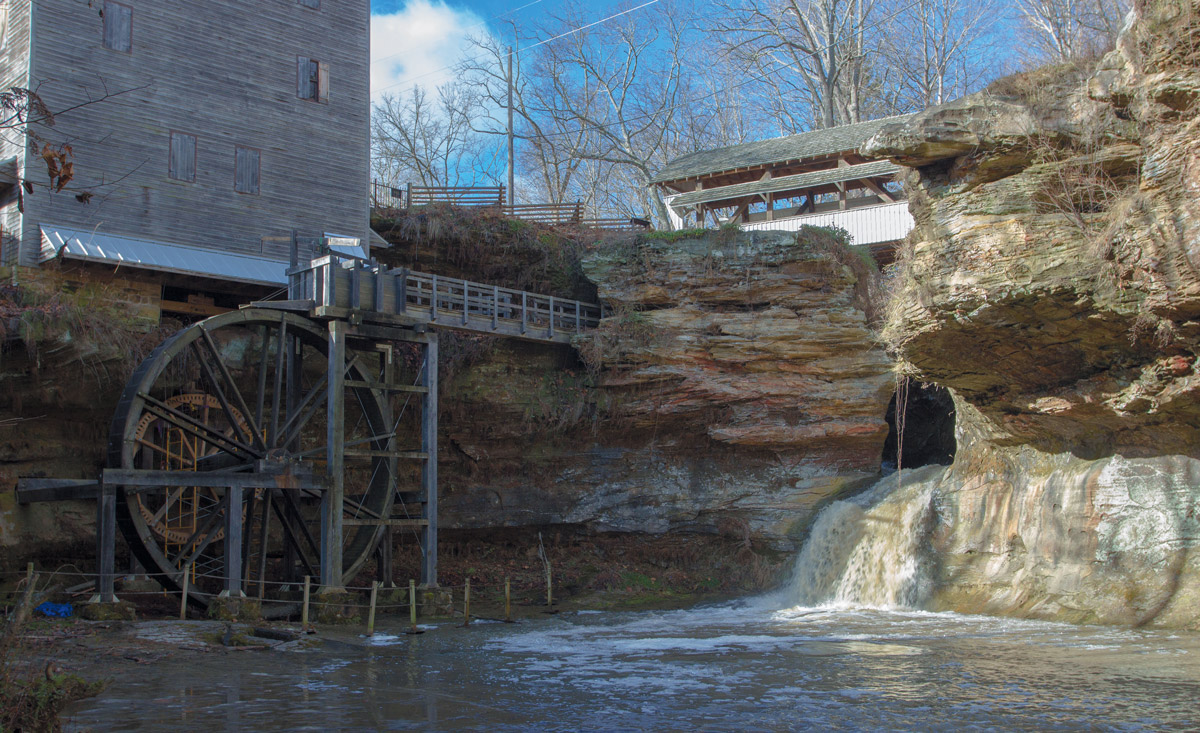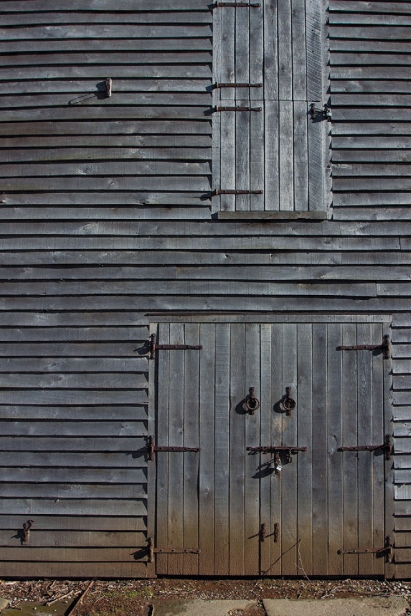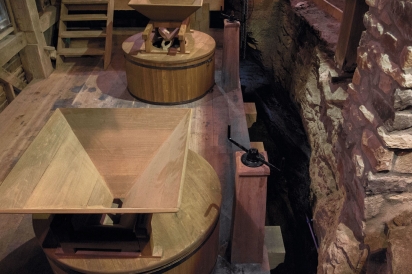Reviving the Rock Mill
Preservationists in Fairfield County restore a historic landmark for mill production
For decades, Fairfield County residents feared the towering Rock Mill might collapse into a rocky gorge of the Hocking River as the 193-year-old mill sat deteriorating on a cliff. Thanks to a team of preservationists led by Dave Fey, newly retired Fairfield County Historical Parks Commission Director, the historic gem is open this summer as a working gristmill to showcase an important chapter of the region’s agriculture heritage.
“The mill changed the settlement of this village,” says Dave. “And, I hated to think my grandson might have to read about its history on a roadside plaque instead of seeing and smelling the place, hearing the grind of the millstones, tasting the flour dust and feeling the hand-hewn oak timbers.
“Now, he can experience our heritage, first hand.”
What Makes A Mill
As Dave offers a preview tour of the restored mill he shares its storied past, which begins in the late 1700s, before Ohio’s statehood.
“Early settlers were drawn to the “fair fields” of Fairfield County,” says Dave. “Here, they planted wheat, corn and other grain crops in the rich topsoil left by glaciers.”
While the settlers’ fields produced bumper crops, their volumes were too great to process by hand. Instead, they loaded their wheat and grain into wagons and pulled them to faraway mills across rugged terrain and the Ohio River to Virginia, Pennsylvania and Kentucky. As so many trips failed and more settlers moved to the area, the need for local mills became more evident.
Joseph Loveland and Hezekiah Smith recognized the opportunity. In 1799, a year before Ebenezer Zane laid out the village of Lancaster, the two proprietors announced their plans to build the first Rock Mill along the Hocking River and called for a log roll to generate lumber for its construction.
“Once this mill and others were built, our county started to explode in agriculture and now continues the legacy today,” says Dave, adding the entrepreneurs eventually added a store, distillery and tavern.
Dave explains many mills had such a “still house” to turn the corn they took as payment for their services into ‘liquid corn’ or whiskey. The whiskey gave them a second product for extra income. Rock Mill’s owners not only had a still house but also opened a tavern—The Blue Ball Tavern—on the other side of where Rock Mill Brewery stands today. A large, blue ball hung from a beam outside the tavern and signaled passing travelers to stop for passengers or packages.
Unfortunately, for Loveland and Smith, the available alcohol created disturbances among the Native Americans and settlers. Soon, the local community forced Loveland and Smith to leave.
In 1820, a flood took out Rock Mill. Four years later, Joseph Bookwalter built the present Rock Mill on higher ground—a durable blackhand sandstone cliff near the Hocking River’s headwaters.
Dave continues the story as he marvels at the craftsmanship involved in the building of the mill, which was a 15-month project.
“Imagine hand-hewing a 65-foot corner beam then positioning it without any modern-day cranes—only levers, pulleys and animals,” says Dave. “The peak reached 100 feet from the gorge and climbed six stories with four above ground and two below.”
Running on Water
The mill was powered by water from the Hocking River and strategically positioned by its headwaters where a 14-foot waterfall spills today. The millers diverted the river’s water to the mill via a 30-foot channel or sluice chiseled 18 feet deep through the sandstone. Water rushed through this sluice to a wooden flume that dumped it directly onto an overshot 26-foot wooden waterwheel. As the water propelled the wheel, its shaft turned a pit wheel and subsequently two sets of millstones.
Dave says the dual millstones were unique to Rock Mill, since most mills only had one set. He explains these disk-like stones were carved with deep grooves and stacked atop one another. The bottom “bed stone” was stationery, and the top “runner stone” turned to grind the grain.
For 81 years, the mill thrived as a grist mill and eventually converted to steam power near the turn of the century. In 1905, the mill closed due to a business conflict and remained vacant for nearly 100 years. In 2003, Robert and Rita Stebelton donated the mill to the Parks Commission, which started the extensive restoration.
“The mill was in pretty bad shape,” says Matthew Barbee, owner of Rockmill Brewery, a craft brewery and tasting room that opened in 2010 on his family’s former horse farm that once was a part of the larger Rockmill Farms.
Recalling the mill’s sadder days, he says “I’d pass the mill every day on my way to high school, as I drove across the covered bridge.”
Today, Matthew couldn’t be more delighted with the transformation. “I’ve been so impressed to watch what’s been done,” he says. “It’s absolutely gorgeous!”
One Stick At a Time
When Dave stepped into the mill for the first time in 2003, the structure was seriously deteriorated, with much of its exterior shell gone.
“There were no floors, no windows and no waterwheel—only an exterior frame that was patched with metal siding and tarps,” he says.
While many may have considered the project hopeless, Dave saw its potential. He laughs, mocking himself as he recounts how naively he stepped into the massive project as the parks commission director.
“I was dumb enough to take it on,” says Dave. “We tackled it one stick at a time.”
The first challenge was to stabilize the structure with steel supports, so he called upon the contractor who had helped the county restore several of its 18 covered bridges. The contractor agreed to donate his equipment and only charge for labor. Next, Dave started fundraising by speaking to groups—eventually making 1,400 presentations—about the mill preservation project and soliciting donations. As he accumulated a sum of money, another phase of work would resume on the project. In 2006, he organized a window campaign, collecting donations of $250 per shuttered window. In 2011, the community passed a levy to fund the parks commission and its historical projects. In addition, the project secured a $150,000 grant from the Ohio Cultural Facilities Commission to restore the lap-siding façade. In total, Dave estimates $1.2 million has been spent of the mill’s restoration, which includes $267,000 for the latest installation of the gears and grinding stones.
In 2006, he first contacted millwright Ben Hassett of Louisville, Kentucky to discuss the project and eventually restore the mechanical parts, including the water wheel, pit wheel and millstones. Ben is one of only a few millwrights working in the United States today and has restored 60 mills in the past 20 years. He built and installed the water wheel in 2012 and the grinding units, last fall. The final steps of the renovation are the installation of a dam and grain handling equipment.
“The wheel is 26 feet and weighs 20,000 pounds making it the largest wooden water wheel in the U.S.,” says Dave. The mill is expected to produce 300 pounds of flour an hour. When open, the mill will run 15 minutes every hour on the weekends.
Watch the Rock Mill in action as the grinding wheels resume after 112 years. Weekend demonstrations are Saturdays and Sundays, 1pm–3pm through the end of October. The mill is located northwest of Lancaster at 1429 Rock Mill Place, NW. Check Rock Mill’s Facebook page or website for details. Also, watch for Facebook updates on the Rock Mill Celebration in late summer. At the celebration, local artisans will be demonstrating old-time crafts like tin punching and selling unique, one-of-a-kind items. The millwright will be on hand to explain the milling equipment and demonstrate its operation. Since parking is limited, transportation will be provided from an off-site parking area. Round out a mill visit with a stop at nearby Rockmill Brewery and its tasting room at 5705 Lithopolis Road NW to sample its noted Belgian-style ales and saisons.









